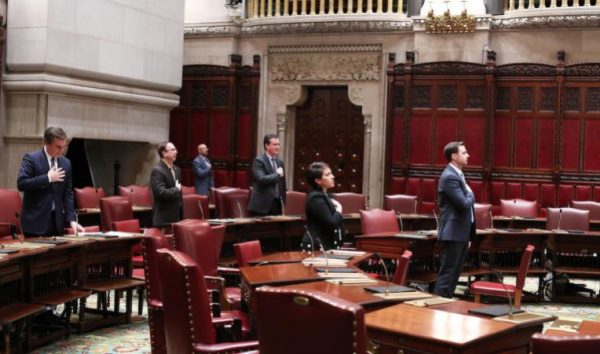Session may resume, with few details on voting technology – City & State
NY Senate Media Services
A scattering of state Senators on the Senate floor March 29th.
The state Legislature appears unlikely to follow the New York City Council in voting-by-Zoom.
April 26, 2020
After weeks of uncertainty, there may be a glimmer of hope for those wanting the state Legislature to get back to the business of legislating.
The Times Union reported on Thursday that the Legislature made tentative plans to resume session in the next two weeks, and that majority conferences in both the Senate and Assembly met privately this week to discuss upcoming legislative priorities. Of course, plans to resume legislating in the next two weeks could always change.
But while the New York City Council debuted a new voting-by-Zoom method of legislating on Wednesday, there are few signs so far that the state Legislature would similarly vote by taking advantage of video conferencing apps such as Zoom. A spokesman for the Senate said that the body has a system for remote voting in place, but did not answer questions about what technology that system uses. A spokesperson for the Assembly didn’t respond to a request for comment.
If the state legislative session does resume, the process of voting remotely could look a lot like it did during the budget process. “I’m not speaking for the conference or the leader, but my expectation is if we were going to go back into session to take up bills, people would still be (in Albany), they would just be in their office the way they were during the budget process,” state Sen. Diane Savino, who chairs the Senate technology committee, told City & State. “I don’t anticipate the likelihood that we’ll all be home in our districts, voting from home.” Savino said that while some lawmakers may choose to participate from their districts, it’s easier to work from Albany and not very hard to social distance while in the state Capitol building.
Both houses used Zoom to pass the budget – they just didn’t use it for voting. Members of the Senate used Zoom to check in with the clerk and mark themselves as present while the budget was being voted on. City & State reported earlier this month that the Senate also had the technology to allow members to speak remotely, though none chose to do so. And when it came to actually casting their votes, both the Senate and Assembly relied on systems of effectively voting by default, showing up on the floor to cast their vote or voting using something called a Rule 9 form.
The last option is traditionally reserved for senators who want to vote against certain bills but can’t physically show up on the Senate floor to do so, but it was used by some during the budget so that senators could maintain social distancing. While voting with the Rule 9 form can technically involve the use of technology – state Sen. Julia Salazar said that she had signed one from her office then emailed it to the Senate floor counsel – it’s a more primitive method of remote voting than what some would like to see the Legislature adopt.
Spokespeople for the Senate have repeatedly said that a system for remote voting is in place, but have not made clear what it involves or how it works. Still, some expect to rely on that system if they do reconvene remotely. “I think the Senate will follow the same protocol that we had during the budget except that we won’t be voting or debating on the floor, but we have the technology in place to both cast votes and hold debates remotely,” state Sen. Brad Hoylman said. “I know they’re working out the final details.”
Earlier this month, some lawmakers, such as Assemblywoman Deborah Glick, were still unclear on the process of remote voting for the Assembly. “I don’t know how it will work,” Glick said during a conference call on April 13th. “I don’t know how we will register votes.”
Andrew Hoppin, the former chief information officer for the state Senate, has been advocating for adopting remote voting, and suggested that the Legislature’s IT staff could purchase and integrate off-the-shelf software to make that happen. Asking lawmakers to voice their votes over Zoom – as the New York City Council did – is one option, but apps geared specifically for government services, like tallying votes, are available too. Good government groups including Common Cause York have also suggested using Zoom or other off-the-shelf software. “The Legislature has the technology to remain in remote session and tackle these issues out in public through virtual, remote technologies. Lawmakers just need to use it,” Common Cause New York’s executive director, Susan Lerner, said during a recent conference call.
The scenario Savino suggests, in which most lawmakers return to Albany, stands in sharp contrast to the New York City Council’s first remote meeting with most lawmakers video-conferencing in from their homes or district offices. Their first meeting on Wednesday wasn’t flawless – there were some issues with the muting function on Zoom when council members were called on to vote, and the livestream timed out for some viewers at one point – but it got the job done. As for the details on how – or whether – remote voting will take off in the state Legislature? Those are still buffering.







